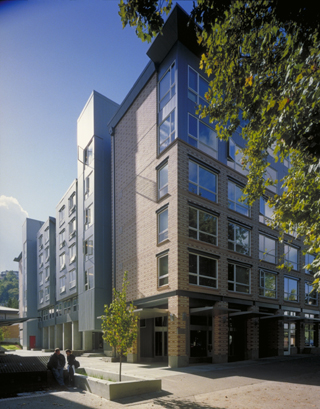
DJC.COM
February 14, 2008
Is LEED living up to its hype?
Interface Engineering

Smith
|
Five years into the U.S. Green Building Council’s LEED program, many ask, “Are green buildings really better places to live and work, and are they truly saving money and the environment?”
A handful of national, regional and local post-occupancy studies indicate a qualified yes — energy savings are typically 30 percent better than other new construction and 50 percent better than existing buildings. Water savings, occupant satisfaction and productivity are all up, and at little or no additional initial cost.
While early results are promising, more study is needed. The primary challenge is convincing owners to conduct post-occupancy studies and share data on how their buildings are performing in real time in the real world.
With climate change in full swing, oil prices increasing and sustainability on many minds, green buildings are a hot market. But do the results support our hope?
National results

Photo by Eckert & Eckert Photography A year after completion, Portland State University's Epler Hall used 49 percent less energy and 27 percent less water than similar projects built to minimum code requirements. |
The U.S. Department of Energy’s High Performance Building database program is collecting energy-use data on public and private green buildings, some of which are LEED certified.
These data show up to 50 percent energy savings compared with ordinary buildings. While the federal government itself has constructed many new buildings to meet LEED criteria, there is little data available on the results of these projects.
The U.S. Green Building Council has many LEED project case studies, but few with post-occupancy data other than the cost of LEED, which commonly requires little or no additional construction dollars.
LEED offers additional points for post-occupancy study, but few projects pursue these credits, and fewer are willing to make the resulting data public. A post-occupancy study includes measuring and verifying energy and water use, and surveying building occupants about their comfort and satisfaction.
Cascadia study
In 2006, the Cascadia Green Building Council commissioned a post-occupancy report on 11 Northwest LEED buildings, both commercial and multifamily residential, with the following results:
• Average actual energy use was at the same level as anticipated for commercial buildings and 10 percent less for residential, with individual buildings typically varying 25 percent from the average.
• Average actual energy use was 40 percent less than for similar existing buildings.
• Average actual water use was slightly more than anticipated.
• Average actual water use was 15 percent less than for similar existing buildings.
• Office building occupant satisfaction was high, including positive productivity impacts from good lighting and air quality, but there were major concerns with noise level and sound privacy (attributable to more open workspaces), and minor concerns about thermal comfort (too hot/too cold).
• Residential building occupant satisfaction was unknown due to little or no response.
GGLO study
There is a new breed of mixed-use projects being built in many larger West Coast cities.
While inherently sustainable due to economies of scale and high density, some developers have gone beyond code-minimum construction by applying Built Green, LEED and other programs to enhance the green urban village concept.
GGLO, a Seattle-area architectural firm specializing in the green market, recently completed a study of seven green mixed-use projects with the following results:
• Actual average energy-use savings is 30 percent compared with existing buildings.
• Where “modeled,” actual energy use is 10 percent less than anticipated, identical to the Cascadia study.
• Actual average water use is 20 percent to 30 percent less than for new conventional multifamily residential buildings.
Epler Hall case study
Epler Hall at Portland State University is a LEED silver project designed by Mithun. Interface Engineering performed the mechanical and electrical engineering. The building’s features include passive heating and cooling, natural ventilation and rainwater harvesting.
After a year of occupancy, the building used 49 percent less energy and 27 percent less water than similar code-minimum construction. The project is generating a 19 percent return on investment for the university with simple payback in six years after a significant water utility rebate.
While the studies above represent a good start in examining LEED building performance, more data is needed.
More owners should install measurement and verification features to verify energy and water savings, and conduct post-occupancy evaluations to survey the health, comfort and productivity of people who live, work and play in these spaces.
The U.S. Green Building Council offers LEED points for measurement and verification and post-occupancy evaluations, but few seek these points because they require follow-up by the operations department — typically a different group from the capital projects department. However, omitting this step limits the feedback needed to improve the process.
While data is limited it is promising. A few areas need work, particularly in water efficiency and acoustics. Incentives are in place to collect more data and new studies are under way.
Please do your part in contributing to the body of knowledge by participating in one of the many green building or sustainable business organizations, most notably the U.S. Green Building Council, represented in our region by the Cascadia Green Building Council. See http://www.cascadiagbc.org for more information.
Doug Smith is an associate principal and senior mechanical engineer with Interface Engineering.
Other Stories:
- Charrettes evolve to help make projects lean and green
- Vancouver convention center goes for the gold
- Affordable green housing: a social, economic priority
- Reduce your footprint, starting with where you work
- Tapping a market by building green
- Let’s get pumped up about heat sharing
- New LEED standards help retailers go green
- What does sustainability mean in practice?
- When sustainability means putting people first
- Rising to the challenge of carbon neutrality
- Dead-end street to get an urban makeover
- New headquarters lets firm walk the green talk
- How one city is getting greener
Copyright ©2009 Seattle Daily Journal and DJC.COM.
Comments? Questions? Contact us.